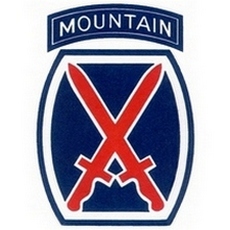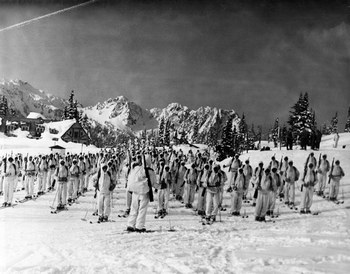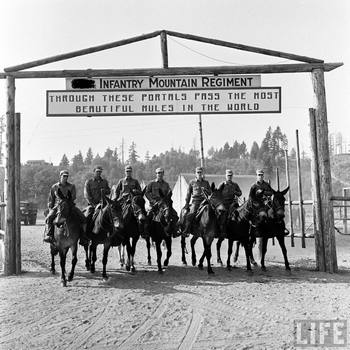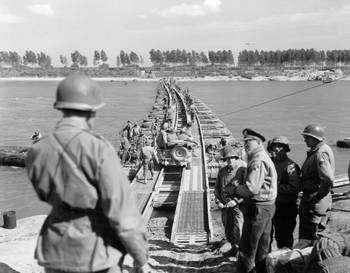 The 10th Mountain Division was the first and only division of Mountaineers formed by the United States Army.
The 10th Mountain Division was the first and only division of Mountaineers formed by the United States Army.
The first units of the division, 87th Regiment, was dates November 15, 1941, on the example of the skiing soldiers of the Finnish army who caused so many problems to the Soviet army in its attempted invasion of the country from the end of November 1939 until the surrender in mid March 1940.
After the Japanese attack on Pear Harbor and America's entry into the war, the training and completion of the 10th Light Division's units underwent a sharp acceleration.
Specific equipment and clothing suitable for mountain troops were studied and tested on field in relation to the low temperatures in which they could find themselves operating.  The training of the men, mostly expert skiers or rock climbers, took place in the high mountains surrounding Camp Hale, in Colorado, at over 6.500 fasl in the cold and snow.
The training of the men, mostly expert skiers or rock climbers, took place in the high mountains surrounding Camp Hale, in Colorado, at over 6.500 fasl in the cold and snow.
On November 6, 1944 near the departure date for the European front, destined to Italy, the Division took the name 10th Mountain Division.
The division was made up of three mountain infantry regiments (85th, 86th and 87th) each composed of three battalions in turn composed of companies from A to M.
In addition to the infantry, there were: three light Field Artillery Battalions (604th - 605th and 616) on mules, the 10th Mountain Anti-tank Infantry battalion made up of the 727th Machine Gun Battalion and the 576th Anti-tank Battery.
The combat forces were supported by a Medical Battalion composed of four medical and one veterinary companies, as well as a horse mounted 10th Recon, the 110th Transmission Company and the 126th Mountain Engineer Battalion.
In Italy the following unit, for more or less long periods, were included in the workforce: the 1125th Armored Field Artillery Battalion and a Regiment of the British Artillery's 178th Lowland Medium Artillery, the 701st Tank Destroyer Battalion and the 751st Tank Battalion. After almost two years of training, on December 11, 1944 the 86th Regiment embarked from Hampton Roads, Virginia, on the USS Argentina bound for Naples where arrived on December 22.
After almost two years of training, on December 11, 1944 the 86th Regiment embarked from Hampton Roads, Virginia, on the USS Argentina bound for Naples where arrived on December 22.
On January 4, 1945 the 85th and 87th Regiments embarked from Hampton Roads, on the USS West Point, bound for Naples where they arrived on January 13, 1945.
On January 6 the three artillery battalions embarked on the USAT General Meigs and arrived in Naples on 18 January.
The transport of troops on Italian territory, up to the foothill of the Gothic Line, took place by train from Naples to Livorno and by military trucks to the waiting areas near Pisa.
The 86th regiment, from the Quercianella holding area near Livorno, entered the front line north of Bagni di Lucca and between 8 and 9 January 1945 took over the elements of Task Force 45 in the Monte Belvedere area protected, on the right flank, by the 1st Brazilian Infantry Division belonging of the Força Expedicionária Brasileira (F.E.B.).
On January 15 ,1945 the 85th and 87th Regiments was camped west of Pisa and entered the front line on January, 20 in the Monte Belvedere area.
Between 28 and 29 January, troops of the 85th and 87th Regiments took over the 86th Regiment, which subsequently led the assault to the German lines on Riva Ridge (Pizzo di Campiano, Monte Cappel Buso, Monte Serrasiccia, Monte Mancinello and Le Piagge*) on the night between 18 and 19 February 1945.
At 11pm, February 19, 1945, General George P. Hays, commander of the 10th Mountain Division, sent the order to the three regiments to begin the attack on the Gothic Line. To accentuate the surprise there was no usual preparatory artillery fire.
The forces in the field were supported by aerial reconnaissance led by "Rover ]oe", coordinated from the ground by the "Rover Pete" team.
The assault of the 87th Regiment developed from the starting line, near the town of Querciola, towards the town of Corona.
The 2nd Battalion headed west, towards the towns of Polla and Rocca Corneta.
The 1st Battalion climbed the left ridge of Monte Belvedere at the same time of the 3rd Battalion, 85th Regiment, which was immediately to its right.
The 1st Battalion, 85th Regiment stormed Monte Gorgolesco and the 3rd Battalion, 86th Regiment headed towards Mazzancana.
The action continued towards Ronchidoso and Monte della Torraccia that was conquered February 24, 1945.
Monte Terminale and Jola di Montese was conquered March, 3 Pietracolora March, 4 and Castel D'aiano March 5, 1945.
The three regiments of the 10th Mountain Division finally stationed themselves between Monte Castellaro, Monte Grande D'Aiano, Monte della Spe, Monte Sinistro e Monte della Castellana for the following four weeks during which the troops were sent in rotation for rest to the rear between Prunetta and Campo Tizzoro, in the province of Pistoia, and Montecatini.
On April 14, 1945 was launched the final assault to what remained of the Gothic Line defenses, the last German bastion before the Po Valley. The Spring Offensive led to the liberation of the towns of Rocca di Roffeno, Tolè on April, 16 Monte Pastore and Savigno.
The Via Emilia were crossed at the Appennine foothill towards the Po Valley, between the city of Modena and Bologna, near Ponte Samoggia to continue, passing through the territories west of the city of San Giovanni in Persiceto and Crevalcore, towards Nonantola, Bomporto up to Bastiglia which was reached April 21.  Between 23 and 24 April the three regiments of the 10th Mountain Division crossed the Po river near Governolo arriving to occupy the Villafranca di Verona airport and Verona itself April 25.
Between 23 and 24 April the three regiments of the 10th Mountain Division crossed the Po river near Governolo arriving to occupy the Villafranca di Verona airport and Verona itself April 25.
April 26 the troops reached the southern shore of Lake Garda, continuing up to Torbole where they entered April 30.
April 28, 1945 the German troops in Italy surrendered and on May 2 laid down their weapons.
May 6, troops of the 3rd Battalion, 86th Regiment encountered, near the Resia Pass, in the Alps between Italy and Austria, the troops of the 44th US Infantry Division coming from central Europe.
The dawn of July 14 saw the 10th Mountain Division deployed from May 20 to Tarcento near the city of Udine. Together with English troops, it had to prevent any westward movements of Tito's partisan forces who had occupied the cities of Trieste, Gorizia and Klagenfurt.
In those days the division received the order to return to America, in preparation for the invasion of Japan planned in Kyushu November 2, 1945.
On August 6, 1945, the city of Hiroshima was destroyed by the first nuclear bomb in the history. Between July 26 and August 2, 1945 from the ports of Livorno (86th Regiment) and Naples (85th and 87th Regiment) the three regiments of the 10th Mountain Division embarked towards America where they arrived between August 7 and August 11, 1945.
The division was deactivated on 30 November 1945 at Camp Carson, Colorado.
During the fighting on Italian territory, the 10th Mountain Division, made up of 19,780 men, had 975 KIA and 3,871 WIA.
The highest losses suffered by an American division on the Italian territory, in relation to the time spent there.
Reactivated February 13, 1985, the division's motto was, and still is, Climb to Glory and derives from the expert climber soldiers who, in the dead of night February 18, 1945 climbed along five steep trails that led to Riva Ridge* to overwhelm the German forces who thought they were safe.
More: Memorie d'Italia museum

